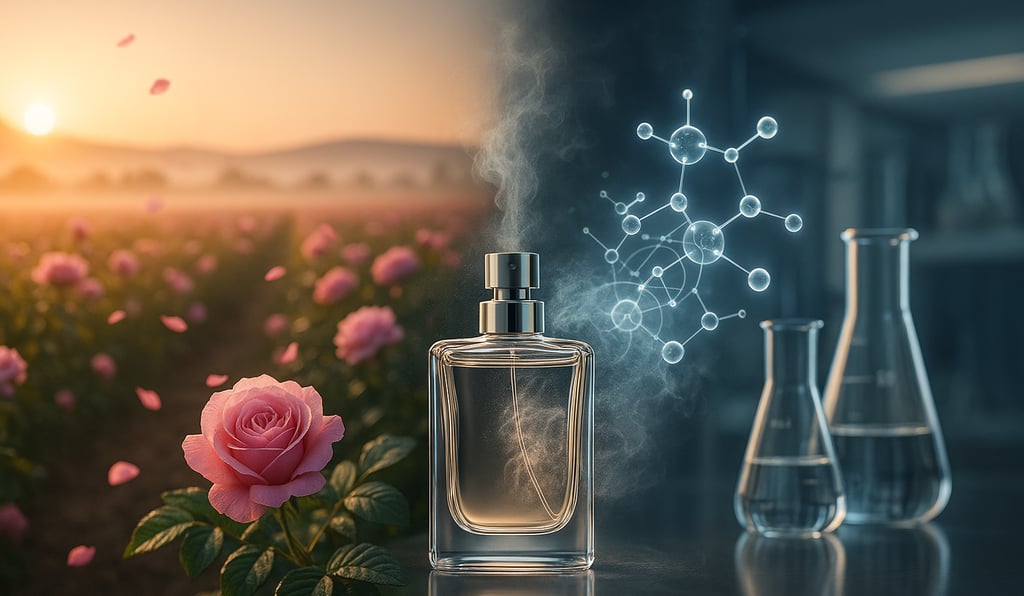The Obsession with ‘Natural’ Is Hurting the Fragrance Industry
Is the demonization of synthetics based on science or sentiment? This piece argues that synthetic molecules can be safer, more sustainable, and just as beautiful as naturals.
THE SCENT DAILY
7/12/20253 min read


Walk into any boutique fragrance shop today, and you’re almost guaranteed to see labels proudly proclaiming their perfumes as "100% natural," "organic," or "chemical-free." These words have become synonymous with quality, purity, and safety in the minds of consumers. Yet, lurking behind these reassuring labels is a problematic misconception: the idea that synthetic ingredients are inherently inferior, harmful, or even toxic.
In the fragrance world, this narrative has become increasingly pervasive. It is clear that it has shaped consumer expectations and market trends. But is this demonization of synthetics rooted in science, or is it merely a sentimental, romanticized notion of what constitutes quality? More crucially, could our obsession with "natural" ingredients actually be hurting the fragrance industry, and more importantly, the environment?
Let’s start by dismantling one prevalent myth: the assumption that "natural" automatically equals "safe." Natural materials, after all, come directly from plants, flowers, roots, and other botanical sources, which sounds innocuous enough. However, nature is not inherently benign. Many natural substances used in perfumery, such as oakmoss, cinnamon, and certain citrus oils, have been associated with allergic reactions and sensitivities. Indeed, regulatory bodies like the International Fragrance Association (IFRA) regularly restrict the use of specific natural ingredients due to safety concerns.
On the other hand, synthetic molecules—often maligned as "chemicals"—can actually offer enhanced safety profiles. Carefully engineered and rigorously tested, these synthetic ingredients often exhibit lower allergenic potential than their natural counterparts. Iso E Super, Ambroxan, and Hedione are prime examples of popular synthetic molecules that not only smell incredibly appealing but also carry minimal risk of irritation or allergic response. Yet, despite their demonstrable benefits, synthetics continue to be viewed skeptically by many consumers who associate anything synthetic with something artificial or harmful.
But safety isn’t the only reason to reconsider our collective mistrust of synthetics. Sustainability, an increasingly vital factor in today’s climate-conscious world, also favors the laboratory. Extracting natural ingredients requires substantial amounts of resources like vast amounts of land, water, energy, and labor. For example, producing just a single kilogram of rose oil demands approximately three tons of rose petals. Multiply this across the global fragrance industry, and the environmental implications quickly become quite staggering. Not to mention, increased demand for rare ingredients often leads to overharvesting that endangers plant species and disrupts ecosystems.
In contrast, synthetic fragrance molecules are produced in controlled laboratory environments, consuming far fewer natural resources. Synthetics can mimic the aroma profiles of rare and endangered botanicals without contributing to ecological degradation. Consider sandalwood: natural sandalwood trees take decades to mature and are critically endangered due to relentless harvesting. Synthetic sandalwood alternatives, such as Sandalore and Polysantol, offer remarkably realistic aromas without threatening biodiversity. Embracing synthetics, therefore, can play a pivotal role in preserving fragile ecosystems.
Yet, the fragrance industry faces significant hurdles in communicating these benefits to consumers who’ve become conditioned to equate synthetic with inferior. This challenge partly arises from marketing strategies that exploit the emotional allure of "natural" products, creating an idealized image that synthetic substances seemingly cannot match. Natural has become a shorthand for authenticity, purity, and luxury—qualities deeply appealing in our highly industrialized and synthetic-filled world. However, this idealization is built on perception rather than empirical evidence.
What many fail to recognize is that the artistry of perfumery is not diminished by the inclusion of synthetic elements. Quite the contrary, synthetic ingredients have revolutionized fragrance creation, opening up new olfactory landscapes that naturals alone cannot achieve. Chanel No. 5 famously incorporated aldehydes, a class of synthetic chemicals, in 1921, forever changing the perfume industry with its uniquely abstract and groundbreaking scent profile. Modern masterpieces like Dior’s Sauvage and Maison Francis Kurkdjian’s Baccarat Rouge 540 similarly rely heavily on synthetics to achieve their iconic status.
Indeed, synthetics often provide perfumers with greater creative flexibility and consistency. Natural ingredients can vary significantly in aroma due to factors like climate, soil conditions, and harvest methods, making it challenging to ensure product consistency across batches. Synthetics, on the other hand, guarantee reproducibility and reliability which are essential qualities for brands that want their fragrance signature to remain consistent year after year.
So why does resistance persist? Partly because the fragrance industry itself has historically contributed to the myth by emphasizing naturals as inherently superior. Brands have capitalized on consumer ignorance and fear. The word "chemical" has been used as a negative buzzword despite the fact that literally everything, including pure water, is chemical by definition.
Addressing these misconceptions requires collective efforts from perfumers, brands, regulatory bodies, and even consumers themselves. Transparent communication and education are critical to helping consumers understand that synthetic does not mean artificial in any pejorative sense. Instead, synthetic ingredients should be marketed in a way that represents human ingenuity. The proof is in the pudding—we can design molecules even more refined than those found in nature. Ones that enhance safety, protect biodiversity, and expand the artistic possibilities of fragrance.
Ultimately, our industry must evolve beyond simplistic binaries of natural versus synthetic. Instead, we should focus on quality, safety, sustainability, and the artistry of scent itself. Rather than falling into the trap of demonizing synthetics based on sentiment and marketing hype, let’s appreciate them for what they truly are: innovations that have broadened what we can do with perfumery, making fragrances safer, more sustainable, and arguably more beautiful than ever before.


